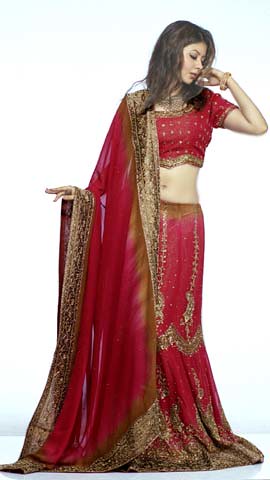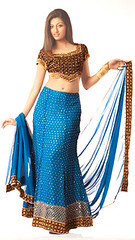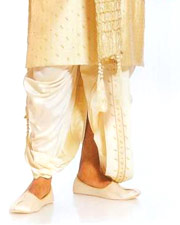5:43 PM
A Glossary to Traditional Indian Attire
Posted by Khush Singh-Celebrity & Indian Bridal Makeup Artist Email this Indiamarks guide to your friends

A major part of any country's culture and people are the clothes they wear. Better known as the 'Traditional Costume or Attire' of a country,in different cultures, what a person wears is often indicative of his to her personal and social identity, marital status, occupation and sometimes-even religion.
Though following these traditions and wearing traditional clothes is slowly reducing in most countries where westernization is coming more into play, costumes and traditional wear will always have an important part, on the most important days...like festivals, weddings and important events and functions.
It maybe not be practical to wear on a daily basis in this day and age but sure enough is part of our culture and nationality which defines us as a race.
Though following these traditions and wearing traditional clothes is slowly reducing in most countries where westernization is coming more into play, costumes and traditional wear will always have an important part, on the most important days...like festivals, weddings and important events and functions.
It maybe not be practical to wear on a daily basis in this day and age but sure enough is part of our culture and nationality which defines us as a race.
Traditional Indian Costumes
 India being so diverse culturally and geographically, almost every region and state in Indian has their own attire.
India being so diverse culturally and geographically, almost every region and state in Indian has their own attire.Some similarities and common factors can be found in these costumes for instance the Sari/Saree can be called the Traditional attire of Indian Women, but the sari is worn differently in different parts of the country.

The traditional attire for Indian Men could be said to be the Kurta-pajama which is a loose fitting long pull over shirt with drawstring pants called the pajama, aptly named because of its simplicity and cos it's very comfortable to wear.
There is one thing to be said about Indian attire as a whole- We're not afraid to wear color! Every region's ethnic wear is vibrant to say the least. Even in day to day life color plays an important part in an Indian's wardrobe. Attire like the Sari or the salwar-kameez allows you to experiment with any color, and it's not only restricted to the womens wear...men's wear including the kurta-pajama or sherwani and even lungi's in the south are worn in every color under the sun.
As every region has its own traditional attire lets take a look at some of this traditional wear region-wise:
Women's Wear
Sari/Saree
 The Sari is probably the best known item of Indian clothing, it is instantly recognizable and all who see it instantly associate it with India. It is essentially an un-stitched long piece of fabric which needs to be draped in a particular way to achieve the fully dressed effect. The Sari is said to be one of the oldest forms of clothing in India. The saree is worn in in different ways in different states of India. However, the most common method is wrapping the cloth around the waist, making pleats in the front and draping the final length around the shoulder. The Sari is considered formal attire in India.
The Sari is probably the best known item of Indian clothing, it is instantly recognizable and all who see it instantly associate it with India. It is essentially an un-stitched long piece of fabric which needs to be draped in a particular way to achieve the fully dressed effect. The Sari is said to be one of the oldest forms of clothing in India. The saree is worn in in different ways in different states of India. However, the most common method is wrapping the cloth around the waist, making pleats in the front and draping the final length around the shoulder. The Sari is considered formal attire in India.SIX YARDS of sheer grace and elegance is what the sari is all about!
Salwar-Kameez
 The Salwar Kameez is probably the most popular of all the Indian clothes. Originally from the Punjab and Kashmir, it is now worn throughout India and by most Indian women living abroad. It’s popularity is due to the fact that is is comfortable, practical, modest yet incredibly elegant and stylish, so much so that it is even becoming popular amongst Western women. Sari's are now reserved more for formal functions and occasions. In the North Punjabi girls and women wear salwar kameez`s with bright colored duppattas.
The Salwar Kameez is probably the most popular of all the Indian clothes. Originally from the Punjab and Kashmir, it is now worn throughout India and by most Indian women living abroad. It’s popularity is due to the fact that is is comfortable, practical, modest yet incredibly elegant and stylish, so much so that it is even becoming popular amongst Western women. Sari's are now reserved more for formal functions and occasions. In the North Punjabi girls and women wear salwar kameez`s with bright colored duppattas. The salwar kameez can come in a variety of fabrics, lengths and cuts but it will always consist of the same three things namely: the kameez (similar to the French word Chemise, French for shirt). This is the dress and can either be loose and flowing or more fitted at the waist with an a-line skirt. It more often than not has slits up the sides which can range from knee length to up to the thigh.The second piece is the salwar, which are the pants or bottom piece. The salwar can be described as huge baggy trousers, usually with a drawstring waist, a low crotch and heavily stitched, stiff cuffs. A version of the salwar kameez is also worn by men known as kurta-pajama.
A duppatta which is a piece of colorful cloth worn around the neck is similar to a stole or scarf and it completes the ensemble.
There are tons of different styles of salwar kameez which is used as a general term for the two piece attire. It's a very versatile clothing style as it can be mixed and matched around with different styles of bottoms or dupattas to change a look completely. The Cuts and fits are also changed to suit a persons body or preferences.

Another style of bottoms is the churidar similar to the Salwar but they are very tight fitting on the leg and incredibly long so that they bunch up around the ankles. These gathers at the ankles look like bangles (churis) and hence the name.
The kameez is sometimes called kurta and can be worn in various lengths and styles. A shrot version of a Kurta known as kurti is usually worn with jean or pants instead of traditional bottoms and is widely worn across the country today.
Lehenga or Ghagra Choli

A choli is a midriff-baring blouse worn in India and other countries where the sari is worn. The choli is cut to fit tightly to the body and has short sleeves with a low neck. The choli is usually cropped, allowing exposure of the navel; the cropped design is particularly well-suited for wear in the sultry South Asian summers. Choli's can be worn longer so they don't expose as much midriff as well.
Women of the Gujarat and Rajasthan countryside may also wear the choli with a gypsy skirt called a lehenga or a Ghagra. A Lehenga is a full skirt worn with a choli also called a gypsy skirt or lehnga. The lehenga is worn in different styles, made of different fabrics and includes unique patterns. The lehenga of Rajasthan and gujarat is known for its bandhni work which is a technique in tie-dye mastered by Hindu women of the region. The ensemble of this full skirt and choli is also called Ghagra Choli in some parts of India.
The more modern skirts of the Lehengas are cut on the bias and have a grand ball gown look to them, the more traditional kind are straight cut but still quite full. This outfit also includes a Dupatta or an odhani.

The states of Punjab and Haryana are famous for the `phulkari (flower-work) shawls that, worn with a tight-fitting choli and gaghra. Phulkari forms the traditional costume of rural women of this region. Phulkaris were made for everyday wear. Usually the border and field of the shawl were not so densely embroidered, with much of the ground cloth exposed. For ceremonial occasions, however, a special kind of phulkari known as a `bagh` (garden) was made, in which the whole of the ground was covered with embroidery, so that the base cloth was not visible at all. These Phulkaris are worn as the Dupatta or Odhani with Lehengas and Ghagra Cholis.
Men's Wear
Kurta-Pyjama/Churidar
Along the same lines as the Salwar-Kameez in women's wear is the men's Kurta Pyjama.
It consist of the same three things just cut differently and sometimes called different names. The Kurta is the top in the form of loose shirt falling either just above or somewhere below the knees of the wearer. It's a pull over type shirt with a few buttons. It has side slits or seems for easy movement. Kurtas are usually teamed with a salwar type bottom which is essentially the same as a womens salwar but cut slightly different. They are baggy drawstring pants that fall loosely and are loved for being comfortable and thats why their called pyjamas. A dupatta is also used to complete this look, but can be left out as well.

The kurta like the kameez can be worn or teamed up with different bottoms to create different ensembles. The Churidar is also worn by men with kurtas. They are the same as the women's churidars and gather at the ankles. Kurtas are also commonly pairs with jeans as well in more recent times.
Dhoti
 The 'pancha' in Telugu, called dhoti in Hindi, 'Laacha' in Punjabi, 'mundu' in Malayalam, 'dhuti' in Bangla, 'veshti' in Tamil, 'dhotar' in Marathi and 'panche' in Kannada, is the traditional garment of men's wear in India. It is a rectangular piece of unstitched cloth, usually around 5 yards long, wrapped about the waist and the legs, and knotted at the waist.
The 'pancha' in Telugu, called dhoti in Hindi, 'Laacha' in Punjabi, 'mundu' in Malayalam, 'dhuti' in Bangla, 'veshti' in Tamil, 'dhotar' in Marathi and 'panche' in Kannada, is the traditional garment of men's wear in India. It is a rectangular piece of unstitched cloth, usually around 5 yards long, wrapped about the waist and the legs, and knotted at the waist.In northern India, the garment is worn with a Kurta on top, the combination known simply as "dhoti kurta", or a "dhuti panjabi" in the East. In southern India, it is worn with an angavastram (another unstitched cloth draped over the shoulders) in Tamil Nadu or else with a "chokka"(shirt) in Andhra Pradesh or "jubba" (a local version of kurta). The Dhoti kurta is considered formal wear in India.
Sherwani
 Sherwani is a coat-like garment buttoned in the front, which reaches down to the knees, or lower. Usually has embroidery or some other type of work on it.A sherwani coat fits close to the body, fastened in the front with buttons, and extends to slightly below knee-length. Sherwanis are usually embroidered or detailed in some way. It's a formal version of a kurta and worn by boys and men at formal functions and occasions. A Sherwani is worn with chudidar bottoms or a dhoti style bottom and is completed with a dupatta and traditional Indian shoes called mojari's or juttis.
Sherwani is a coat-like garment buttoned in the front, which reaches down to the knees, or lower. Usually has embroidery or some other type of work on it.A sherwani coat fits close to the body, fastened in the front with buttons, and extends to slightly below knee-length. Sherwanis are usually embroidered or detailed in some way. It's a formal version of a kurta and worn by boys and men at formal functions and occasions. A Sherwani is worn with chudidar bottoms or a dhoti style bottom and is completed with a dupatta and traditional Indian shoes called mojari's or juttis. Lungi
 The lungi is a type of wrap-around garment worn in many of the southern states of India. It's a rectangular piece of cloth little bigger than a towel and is wrapped around kind of like a sarong. In Kerala the lungi, locally known as Kaili or Kalli Mundu, is worn by both men and women. It is considered a casual dress or working dress of physical labourers. Lungis are generally colourful, and with varying designs. The plain white version of a lungi is known as a mundu. For more ceremonial occasions (like weddings), mundus often bear a golden embroidery known as kasavu.
The lungi is a type of wrap-around garment worn in many of the southern states of India. It's a rectangular piece of cloth little bigger than a towel and is wrapped around kind of like a sarong. In Kerala the lungi, locally known as Kaili or Kalli Mundu, is worn by both men and women. It is considered a casual dress or working dress of physical labourers. Lungis are generally colourful, and with varying designs. The plain white version of a lungi is known as a mundu. For more ceremonial occasions (like weddings), mundus often bear a golden embroidery known as kasavu.Unlike dhotis, which are linear like sheets, lungis are sewn into a tube shape like a skirt. Depending on local tradition, lungis can be worn by men and/or women, are tied or fastened in various ways, and can be used in different cultural activities, ranging from normal daily life to elaborate wedding ceremonies. For daily purposes, a simple double knot is most popular, since it is least likely to slip or come undone. Another way of wearing is it by draping it around the waist and pleating it in the front at the groin.
Kerala men folk generally tuck up their mundus or lungis. The bottom of the garment is pulled up and tied back on to the waist. This would make the mundu or lungi only cover the body from the waist to the knees. In this fashion it somewhat resembles a kilt, but without pleats. The lungi is thought to be quite comfortable, as its length can be adjusted rather easily. It is particularly popular in regions where the heat and humidity create an unpleasant climate for trousers.


























4 comments:
Nicely described all traditional clothes and their importance like it.
===================================
Wedding Hair and Makeup
Nice Post....Beautiful pics. Useful Information for peoples who are looking for traditional wear. Great job done keep it up!
how to buy the kurta and sherwani easily and cheap you can me ??
Excellent post. I want to thank you for this informative post. I really appreciate sharing this great post. Keep up your work.
Best Makeup studio in Hyderabad
professional makeup studio in hyderabad
Post a Comment